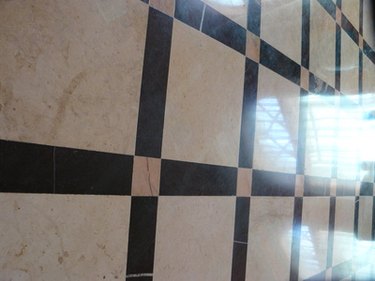
The instant that foot traffic is allowed on a freshly finished VCT (vinyl composition tile) floor, the finish becomes soiled and starts to wear off. Shoe soles are abrasive to floor finishes and, even worse, the grit and dust brought in from outside causes floors to look dirty and in need of refinishing. Buffing a floor on a regular basis, however, can extend the time between stripping and re-waxing.
Buffing With a Standard Side-to-Side Machine
Video of the Day
A VCT floor, which has a finish of standard 14 percent to 16 percent solids floor finish, can be buffed with a 175-rpm side-to-side floor machine. The floor should be mopped with clean water and a pH neutral cleaner. The 175-rpm machine with a red buffing pad will remove most minor scratches after the floor has dried. The buffer handle should be adjusted to about belt level. Lifting the handle a little will make the machine glide to the right, and lowering the handle will allow the machine to buff to the left. Following buffing with the red pad, the pad should be replaced with a white polishing pad and buffed again.
Video of the Day
High-Speed Buffing
High-speed buffing uses a 350-rpm floor machine that operates in the same side-to-side manner as a 175-rpm machine. A 350-rpm machine can be used with a spray buff chemical to enhance the shine of the floor. The spray should be applied just ahead of the pad and worked into the floor until it is dry. Work should be done in small sections to prevent the spray buff solution from drying on the floor before it can be worked in by the buffer.
Ultra High-Speed Burnishing
Because of advancements in polymer technology, new finishes have been developed that require buffing at extremely high rpms of up to 3,000 rpm. The burnishing process produces floors that have a wet look. After the floor has been dust mopped, a fine mist of floor restorer is sprayed on the floor just ahead of the burnisher. The burnisher operator then walks the burnisher across the floor in straight lines instead of the side-to-side motion of a conventional floor buffer. The more a floor is burnished, the harder the finish becomes. Burnishing with an ultra high-speed machine extends the time between stripping the finish off the floor and re-finishing.
Stripping
A floor that can no longer be improved by cleaning, buffing or burnishing must be stripped of the existing finish and recoated. Stripping is done by using a commercial stripping solution that is wet-mopped onto the floor. After the stripping solution has had a time to loosen the floor finish's bond to the tile, it should be buffed with a 175-rpm buffer with a black stripping pad. The floor is then vacuumed with a wet/dry vacuum and rinsed thoroughly before new finish is applied.
Waxing
Although the term "wax" is the common name given to the solution put on a VCT floor, it is actually not wax but a solution of polymers that make up floor finish. Some finishes do, however, contain small amounts of carnauba wax. The finish should always be applied with a nylon or nylon blend mop. Cotton mops leave fibers in the finish that give the floor a very unappealing look. Most floors require at least three coats of finish, and at least 20 minutes should be allowed after the floor is thoroughly dry before a new coat is applied or walked on.